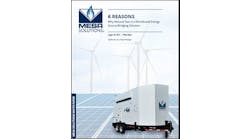The true value of energy storage is misunderstood due to a narrow focus on the cost of investing in it, says a new report from the World Energy Council.
The report, “E-storage – shifting from cost to value,” which addresses wind and solar applications, says that current methods of evaluating energy storage are misleading and hinder the progress of the industry.
The report also estimates that energy storage costs will fall by as much as 70 percent over the next 15 years due to the adoption of new technologies.
Energy storage is viewed as a game-changer. Its flexibility could solve problems related to integrating wind and solar energy and help grid operators manage resources more efficiently. But a narrow methodology for evaluating its value hurts the industry, says the report.
Specifically, the World Energy Council found that focusing on ‘levelized cost of storage’ (LCOS) alone can be misleading.
“Throughout the cost modeling process, the same issues repeatedly emerged, namely the importance of defining the business model under consideration and how the storage plant was being operated,” says the report.
Clear challenges exist in using LCOS as a metric to determine storage costs. For one, storage levelized costs are arbitrary: “The amount of energy (kWh) stored and discharged by the storage plant over a period can vary depending on the application.”
In addition, storage levelized costs are incomplete. “They do not cover the needed business models and its characteristics for storage,” says the report. “Since it neglects higher potential revenues, e.g., from providing flexibility, it is a simplified approach for the actual value of storage.”
The report’s recommendations include:
- Technologies with the lowest LCOS shouldn’t necessarily be chosen. “Cheapest is not always best, or possible,” says the report.
- Storage should be evaluated through “holistic case studies within a specific context,” rather than by using generic cost models.
- To speed development of flexible markets, the industry should work with transmission and distribution system operators and regulators “to help quantify and realize the true potential value of increasing system flexibility.”
- Establish policies and regulations that boost commercial deployment of energy storage technologies.
- Include storage as an important component of grid expansion plans.
It’s important to shift the focus from cost to value, the report says. The authors note that the current model is “a legacy from the renewables industry,” which tends to focus narrowly on levelized costs.” It does so because renewables benefit from policies that de-risk revenue streams.
The focus on levelized cost also stems from the fact that most energy markets do not sufficiently value flexibility.
“This narrow focus on levelized cost helps explain why the business case for storage is often poorly formulated,” says the report.
What is the true value of energy storage?
From a country and societal perspective, the value of energy storage lies in its “ability to provide power quality and reliability, and security of supply. This can be in the form of uninterrupted power supply to end-users, providing some reserve margin or initial power to restart the grid after a blackout. In this context, high reliability is more important than high costs, the report says.
The World Energy Council wants policymakers to recognize the various benefits of energy storage. Frequently included in microgrids, energy storage can help bring down the cost of home solar systems, spur growth in the electric car industry, and help reduce strain on the grid and manage electricity pricing.
“To take full advantage of the growing wind and solar electricity shares, policymakers must review electricity market design so as to incentivize the build-up of storage capacity and ensure reliable and affordable electricity supply,” the report says.
Find the report here







